Identifying Your Steinway and Sons Piano


These pictures illustrate where to look for the Serial and Model number
(above left), and Part number (above right) for your
Steinway and Sons Grand Piano. These numbers can be easily
identified on the plate, underneath the music rack (which
simply slides out of the piano). If the numbers are not
on your Steinway, it has more than likely been refinished
and carelessly left off the instrument by the refinisher.
Not to worry! Part numbers and Serial Numbers are in
multiple places on Steinway instruments...it will just
take a little more effort to find them! The word "Ebonized" indicates
that the piano was destined to have a black finish.
|
Patented Steinway and Sons Grand Action
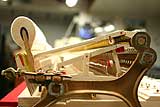
Here we see a side view of the famous, patented Steinway
and Sons Grand action. Notice the 3 Tubular Metallic Action Rails that
hold the flanges and let-off buttons in place. Steinway has used this
type of action frame for over 100 years. New Renner Action Parts and Hammers
are installed, and this "stack" sits atop a brand new keyset
with Genuine legal ivory keytops. The ultimate in piano action restoration!
|
Renner Damper Back Action Replacement
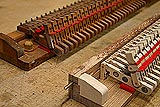

Above are pictures of a Renner Damper Tray Replacement, completed and ready for installation into a Steinway Grand Piano. Renner's replacement tray duplicates Steinway's original, and most desired, tray configuration (the "long-arm" underlever), which enables us to use the exact geometry necessary to achieve the best in damper system performance. Additionally, this also allows us to replace the myriad of Teflon era damper systems out there that have the geometrically incorrect "short-arm" levers which contribute to poor damper performance, poor pedal performance, and premature key-end felt wear. The damper system is also one of the most overlooked components in the wholesale piano restoration business today.
|
Bead Blast Cleaning of Steinway and Sons Piano Action Stack to Remove Corrosion
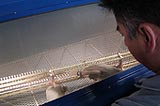
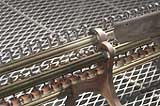
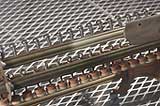
The
finest glass beads available are used in our sandblasting
cabinet (which can house an entire concert grand action),
to remove years of corrosion and dirt. Notice the screws
for the piano action parts are installed not only to
clean them, but to prevent the glass beads from clogging
the rails.
|
Vintage Steinway and Sons Model A1 Grand Piano
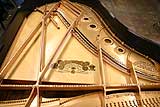
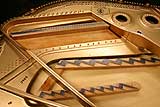
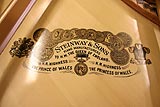
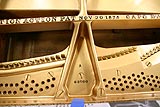
Here we see very thorough belly work on the first Model A Steinway
design ... the A1 6'1" piano. This piano includes new pinblock,
new soundboard with bridge cap, and rim and case repairs.
Steinway developed 2 more versions of the model A culminating with the
A3, at 6'4" long.
Note this early design incorporates a third bridge to
accommodate 9 notes in the tenor section of the piano that utilize bass
strings (2 double and 7 trichords). This scale design has some inherent
drawbacks and was quickly replaced with the A2 that removed the third
bridge.
|
Old Piano Bridge vs. New Piano Bridge
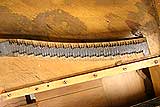
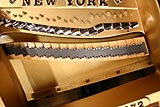
Above left, is an old original bridge upon dismantling of the
piano for restoration. On the right is a brand new reproduction.
|
Restored Steinway Treble Bridge Section

This treble bridge section has been cleaned, renotched,
repinned and restrung on a Steinway and Sons Grand Piano.

|
Steinway and Sons Early Front Duplex Bearing Bars



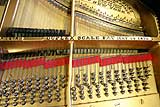
Notice
that each note on these Steinway and Sons early front
duplex bearing bars has an individual rest located in
precisely the correct position. The last picture (above
far right) shows Steinway's later design change to generic
slanted bars that are still used to this day.
|
Genuine Pre-Ban Legal Ivory Keytops


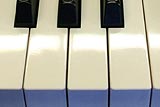
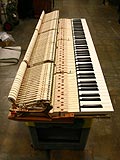
Here we see the brand new keyset reproduction for the
1920’s Vintage Steinway Action shown above, with genuine pre-ban
legal ivory. This one piece Ivory is extremely old,
handsome and valuable, and is reserved for the most
authentic restorations possible. This piano must always
have the Letter of Authenticity with it, and may never
be transported out of the country.
|
Teflon Piano Action Components - Genuine Renner Replacement Parts
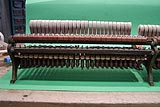

Above are Teflon action components before and after genuine Renner
parts have been installed. Note the cleanliness of the the
stack and uniformity of the parts installed.
|
Piano Hammer Action Components - Using Genuine Renner Replacement Parts

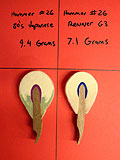
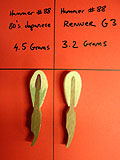
One of the most common and major problems in piano action rebuilding today is the incorrect use of heavy hammers in Vintage Steinway pianos. The Japanese hammers that were used predominantly in the 1980's, are substantially heavier than the current special order Premium Renner Blue Hammers that we use on most Vintage Steinway and Sons Pianos.
The most significant problem visible in this example is at note #26 (center photo), where we see the Japanese hammer is 2.3 grams heavier than the Renner replacement. Understanding that each gram at the hammer end of the shank increases touch-weight by 5 grams at the key, the Japanese hammer would make note #26 about 12 grams heavier to the touch! Amplify this with incorrect parts selection that have geometry problems, and it is easy to see how an inexperienced technician can ruin the performance of a Steinway piano action.
It is not uncommon for us to see poorly restored Steinway piano actions with down-weight measurements of 90 grams, and up-weight measurements of as low as 10 grams. In addition to that, many technicians will try to compensate for these poor performance numbers by inserting 6, 7, or sometimes even 8 leads in a desperate attempt to improve the touch of the piano. This is futile exercise that only makes the situation worse.
|
Steinway and Sons Piano Hammer Placement

Current Steinway and Sons piano specifications call for
the Hammers to be hung on the shank at
51/8".
Vintage Steinway actions have
Hammers that are hung anywhere from 5" to
51/16"
on the
shank. Here, a 1/8" difference would be drastic if not corrected
properly! In fact, the last few upper octaves of the piano
are the most crucial for hammer placement. Our hammers
are hung according to the best possible sound produced,
in relation to the optimal placement of the action fore
and aft. "Pre-hung" hammers
on shanks available from the factory do not work properly
in most older Steinway and Sons Pianos.
|
Vintage Steinway Pianos and Verdigris


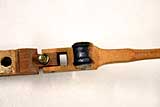
For years on early Vintage Steinways, the action parts were dipped
in a paraffin oil to act as a preservative for the wood.
This accounts for the dark color of Vintage Steinway parts. A drawback
of the dipping solution is the chemical reaction with the centerpins
and all the moving parts, resulting in what is known as Verdigris. This
Verdigris gums up on the centerpins and felt (the green patina shown
in the close-up), and results in sluggish action parts. This is one
of the most major problems with older Steinway pianos. There are no
permanent fixes for this condition other than replacing the defective
components with new parts.
|
Replacing the Agraffes is Standard Procedure When We Rebuild Steinway Pianos


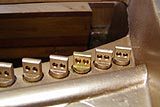
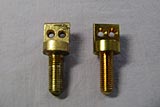
All of our rebuilt Steinway and Sons Pianos will include replacing
the agraffes. Agraffes are made of brass, and if they
have been over-torqued at the factory, they will eventually
break. This will take 70 years sometimes, but it will
happen! Nonetheless, new clean agraffes not only look
nice, but contribute to better tone in the piano. The
steel wire that goes through the agraffes is harder than
the brass, so it will eventually deform the round holes
making them oval.
|
Filing of the Capo D'Astro Bar When Restoring Pianos



Along with replacement of the agraffes, Capo bar filing is essential
to remove old string grooves, and to make sure the profile
of the bar is at its optimal shape. This is one of the
most overlooked steps in the "wholesale
piano rebuilding" end of this industry.
|
Rebushing of the Piano Keys


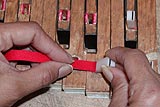
In order to achieve a consistent
feel for the action, rebushing the keys is a crucial
step in the piano restoration process. Only the highest
quality felt material and installation processes are
used for perfect results.
|
Polishing Piano Keytops
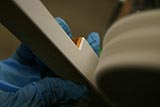
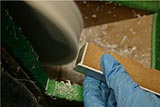
Polishing of piano keytops is a necessary maintenance to restore luster
to both plastic and Ivory keytops. Rouge selection, polishing
wheel selection, and wheel speed are important factors
in achieving the perfect results.
|
Measuring Piano Key Dip on the Action
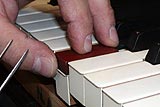
Proper key dip is essential
for the pianist to be able to reproduce the softest
pianissimo to the loudest fortissimo. Key dip can also
be set to a customer's preference to achieve the action "feel" that
they prefer.

|
Traveling of the Piano Hammershank


Traveling of the hammershank in order to insure that the hammer will
advance and strike the strings in the appropriate manner.
|
Accurately Reproduced Vintage Steinway Hammer-Butt Replacements
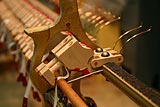

Here we see a replacement hammer-butt for a Vintage Steinway upright
(above right). Imadegawa Company of Japan is currently
the most accurate reproducer of this hard to find component.
Even the damper levers and wippens are reproduced to
the exact dimension needed in order to insure a proper
feel and action response. Vintage Steinway upright pianos
excel when these components are used to restore the action
of the piano. Abel hammer samples prehung at each end
section are shown above left.
|